Lesson 9: Unofficial Words, Interjections, Commands
In this lesson, we learn how to form proper names and unofficial words. We also cover addressing people and using commands. We will use the same vocabulary and grammar that you’ll find jan Pije’s lesson 9. There are two additional words that show up today as well, soweli and pi but if you haven’t learned them yet don’t worry you will still be able to understand this lesson. You may also notice there are a couple example sentences that come from jan Ote’s jan Kikamesi.

a

awen

mama

mije

meli

mu

nimi

o

pona

toki

cartouche

comma
unofficial words
In lesson 2 we learned how to write out the syllable glyphs. Take a look at this lesson again is you need a refresher. These are the glyphs we use to spell out unofficial words that have been “tokiponized”.
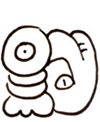
sonja
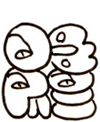
akanisa
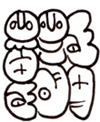
intenasijonale
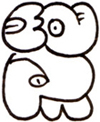
nujoka
cartouche
toki pona uses capital letters to distinguish these foreign words, here we infix the glyphs in a cartouche.

Sonja
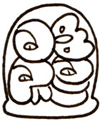
Akanisa
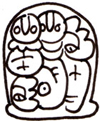
Intenasijonale
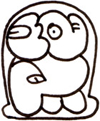
Nujoka
head noun
Since all unofficial words need to modify a noun, this will often rest on top of the cartouche, acting like a head, although it can also be placed anywhere that follows block order rules.
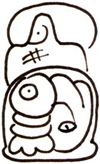
jan Sonja
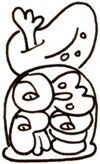
ma Akanisa
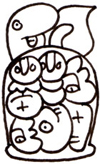
toki suli
Intenasijonale
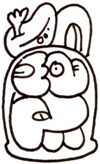
ma tomo Nujoka
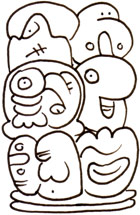
jan sonja li mama pi toki pona.
You can even mix in whole word blocks like the toki pona in jan sonja li mama pi toki pona here.
Notice this is also a way to break from container rules if you want to use li as an in-line block rather than having it surround the verb. This works for any particle or preposition that would normally act as a container.
organizing syllable glyphs
First let me say, as much as I might want to stick the head noun on top of the cartouche when given the chance, inside of a sentence it often makes more sense to move the pieces around to fit the situation.
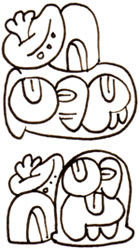
ma tomo Uluku
Often the head noun is better positioned to the side. And sometimes the cartouche becomes long and thin, in which case I rotate it clockwise a quarter turn so the foot is on the left. You could rotate the foot to the right too, I just tend towards the left because that’s how the Egyptians did it.
These two versions of ma tomo Uluku might look strange on their own, but later in this lesson we will see them arranged in both these ways inside of full sentences.
syllable breaks
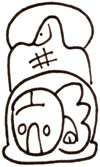
jan Tina
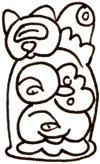
soweli sewi
Animan
When reading linear text written with one character for each consonant and vowel, it is sometimes easy to forget toki pona is actually a syllabic language. Remember that only the first syllable can begin without a consonant, even though all syllables can end with n. So make sure if there is a syllable starting with an n that the n is used as a container for the vowel, and not attached to the bottom of another glyph. For example Tina is jan Ti-na, not Tin-a, and the monkey god Haniman is soweli sewi A-ni-man, not An-i-man.
Long words are best organized into columns
Breaking toki pona into syllables is much more linear in nature than working with containers and infixes. Since the syllable glyphs are pretty regular in form, when it comes time to organize them it is best to break them into regular columns. Also be aware that the n and the l containers are thinner than the others. Sometimes this can work to one’s advantage and sometimes it requires a little stretching or squishing.
See above how nicely the na and la glyphs fill in the last column of Intenasijonale? But the other na is a little thin in the fleft column, and this space needs to be taken up by the jo in the second column. I can’t give you a clear set of rules that will work in all situations, so let me show you by example how I might solve fitting an unofficial word into a cartouche.
soweli Kijetesantakalu
Lets look at jan Sonja’s April Fools day word kijetesantakalu as an extreme example of how to organize syllable glyphs. First we know we have seven syllable glyphs to work with.

kijetesantakalu
Seven is a prime number so we know right away we won’t have a nice regular grid to work with. A single column or row is too long, so our next choice is two or three columns. Lets look at two columns first.
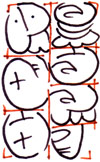
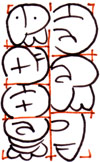
Ok, they’re both passible, but you know what bothers me? Either way the san glyph is going to be squeezed into the column with the extra glyph, and with the n on the bottom it’s already a little taller than the others. Also the l is on the bottom right side, and its hard to stretch it out enough to fill in the space. Either way, the whole block looks like it would fall over to the right.
Let’s try three columns next. We have three choices now, because one of the three columns will have three glyps.
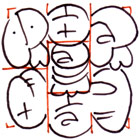
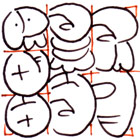

If three glyphs run down in the middle we have the same problem with san so that means the extra glyph is best on the left or right.
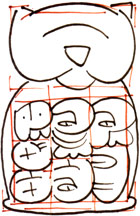
I like the version with three glyphs on the left best because that also gives li space to stretch up on the bottom right. Next I’m going to start stretching the san in the middle out even more and push the ta below it into a rounder shape. If this really was an official word, we’d be done now, but I’m going to add a cartouche and head glyph.
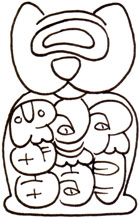
soweli Kijetesantakalu
I’m drawing this out here in different color pens for demonstration purposes, but you can try doing your sketching with a light colored pencil first, or tracing from your sketches onto a new sheet for the final drawing. As I make the final drawing, I’m going to drop the head down slightly over the top of the cartouche, and fill in the details.
I really could go on forever like this, we didn’t even look at a four column grid, but let’s call done done and go look at commands.
Commands
The rest of this chapter is going to focus on using o for commands and addressing others. Lets start with simple commands starting with o because they are really straight forward. To use o with commands, simply use the glyph with normal block structure rules.

o toki!
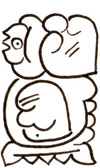
o awen e mama!
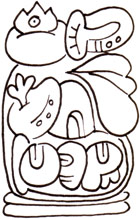
o kama tawa ma tomo Uluku.
In this way o works similar to the first sentences we learned to draw with mi or sina as the subject. o operates in place of the subject, and the verb does not require li.
o with a subject
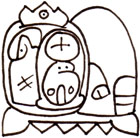
jan Epi o a!

soweli Kuti o
mu!
When the sentence has a subject, o functions as a container. The subject glyph and any cartouche attached to it all go within the o.
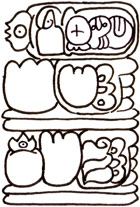
jan Enkitu o moku e moku ni. o moku e telo ni.
It is somewhat different from the containers we have see so far, because when we write the sentence out, the name comes before the o. This is an exception to the block order rules.
Later on we will see one one other container, la, that reverses the block order rules in this way. These exceptions shouldn’t be too hard to get used to. Just remember that the o refers to this subject so the subject rests inside the o, just as prepsitions refer to the direct objects they contain.
Addressing People
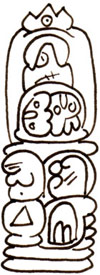
jan Niki o,
mama meli li
awen e sina.
When we are addressing others, but not giving direct orders, the grammar of the sentence is different. Everything that comes after the o is a complete sentence with its own subject.
The o is still connected to the person who is being address, so this is what we infix in the o. then a comma is added between the o container and the rest of the sentence to make the separation more apparent.
Just as this comma isn’t strictly necessary when writing out the toki pona, you can leave it out here too if need be.
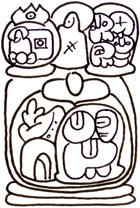
jan lili mi o, jan Kikamesi li lon ma tomo Uluku.
I don’t use this comma glyph as often as I might use a comma when writing, since much of the infixing we are doing serves to group the language just as a comma might. Also without clauses, toki pona has relatively few uses for commas in general. Feel free however to use this glyph in the middle of your sentence block structures if you need to break the glyphs up to create a pause or emphasize the block order.
